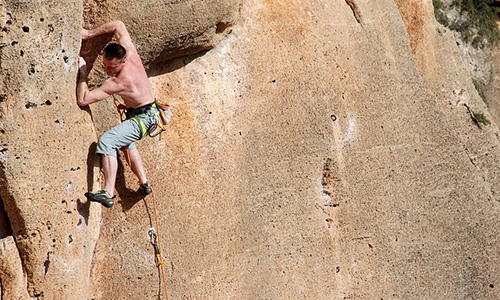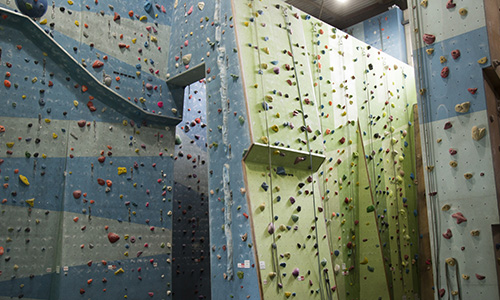A Beginner's Guide: Different Types of Rock Climbing
Author

Chris shares his passion for cycling, hiking, skiing, and climbing from Buxton, in the Peak District. As a blogger for Outdoor Look, Chris shares outdoor tips and indoor tricks to help you get the most out of your time spent outside. When he's not out adventuring he's making videos or trying to keep up with his 4-year-old son.
What is Rock Climbing?
 Climbing, the people around you ask you various questions such as Are you going to free climb? Is there any safety measure on the walls? And more.
Climbing, the people around you ask you various questions such as Are you going to free climb? Is there any safety measure on the walls? And more.
So, we have made a list of different types of rock climbing to make the concept clearer.
Aid Climbing
Aid climbing involves climbing upwards with the help of a climbing gear like a ladder with webbing loops. This type of climbing has been popular since the 1900s as it is an original style to climb large vertical walls. Aid climbing is still famous in places like California and Yosemite. The cams, nuts, and hooks are some of the tools used in aid climbing.
Free Climbing
In free climbing, a participant uses his own power to progress in an upward direction. They use climbing equipment like ropes for protection during climbing.
Free Soloing
This is the highest consequence style of rock climbing. Free soloing involves climbing a rock solo without the use of ropes or any other climbing equipment. Climbers only have their shoes and chalk. In this type of climbing, falls can lead to serious injuries or death. This is the reason that only a few of elite climbers prefer free soloing.
Bouldering
If you want to practice rock climbing indoors, go for bouldering. Like free soloing, here also no ropes or equipment is used. You just require your climbing shoes and chalk. In climbing gyms, there are padded floors that absorb the fall impacts effectively once you have learnt to fall safely.
Lead Climbing
In lead climbing, the rope directly goes with the climber from the base of the route. As the climber ascends, the rope is clipped into the bolts which are secured to the wall or trad gear.
Traditional Climbing
 In Trad climbing, a group of climbers or a solo climber climbs a rock formation with all the climbing gear to ensure protection against falls. Once, the passage is completed, they remove all the gear. You may find bolt-protected-crux or bolted anchors on a trad route.
In Trad climbing, a group of climbers or a solo climber climbs a rock formation with all the climbing gear to ensure protection against falls. Once, the passage is completed, they remove all the gear. You may find bolt-protected-crux or bolted anchors on a trad route.
Often, vertical crack systems are followed on the trad climbs. In such a case, the climbers use hand and foot jams to progress upwards.
Sport Climbing
Sport climbing is somewhat related to roped climbing in a gym. The variable sport climbing routes include overhanging gymnastic-type routes, low-angle slabs, and technical vertical lines. The rocks have permanent anchors secured by the route climbers. This helps climbers to clip a rope for security against falls.
Make sure to check the climbing grades before selecting a type of climbing. For instance, in North America, sport climbing routes are graded 5th class using YDS (Yosemite Decimal System). This means a technical gear is suggested on the route.
If you want to climb an easier route, look for the 5.7 grade. The challenging routes have 5.13a grade.
These are some of the various types of climbing styles that you can choose according to the difficulty level and expertise.
Author

Chris shares his passion for cycling, hiking, skiing, and climbing from Buxton, in the Peak District. As a blogger for Outdoor Look, Chris shares outdoor tips and indoor tricks to help you get the most out of your time spent outside. When he's not out adventuring he's making videos or trying to keep up with his 4-year-old son.
- Speed Up Your Post-Hike Recovery with These 6 Essential Tips
- Cycling through Tranquil Roads and Coastal Views on the Isle of Wight
- The Essential Guide to Hiking Safety: 5 Tips Every Hiker Should Know
- Run Smart, Run Strong: Your Guide to Injury-Free Running
- Embrace Biking: Essential Tips for Beginners
Categories
- Sport (28)
- Product Reviews (3)
- Team Outdoor Look (7)
- Mike Wild (2)
- Mike Payton (2)
- Suse Hammond-Pears (3)
- Snowboarding (12)
- Latest Offers (105)
- Shop Talk (1)
- Competitions (7)
- Walking (413)
- Lifestyle Fashion (8)
- Travel (86)
- Kit Guides (176)
- Workwear Clothing (6)
- Safety Workwear (4)
- Health/Fitness (289)
- Skiing (91)
- Great Outdoors (1316)
- Cycling (92)
- January 2025
- December 2024
- November 2024
- October 2024
- September 2024
- August 2024
- July 2024
- June 2024
- May 2024
- April 2024
- March 2024
- February 2024
- January 2024
- December 2023
- November 2023
- October 2023
- September 2023
- August 2023
- July 2023
- June 2023
- May 2023
- April 2023
- March 2023
- February 2023
- January 2023
- December 2022
- November 2022
- October 2022
- September 2022
- August 2022
- July 2022
- June 2022
- May 2022
- April 2022
- March 2022
- February 2022
- January 2022
- December 2021
- November 2021
- October 2021
- September 2021
- August 2021
- July 2021
- June 2021
- May 2021
- April 2021
- March 2021
- February 2021
- January 2021
- December 2020
- November 2020
- October 2020
- September 2020
- August 2020
- July 2020
- June 2020
- May 2020
- April 2020
- March 2020
- February 2020
- January 2020
- December 2019
- November 2019
- October 2019
- September 2019
- August 2019
- July 2019
- June 2019
- May 2019
- April 2019
- March 2019
- February 2019
- January 2019
- December 2018
- November 2018
- October 2018
- September 2018
- August 2018
- July 2018
- June 2018
- May 2018
- April 2018
- March 2018
- February 2018
- January 2018
- December 2017
- November 2017
- October 2017
- September 2017
- August 2017
- July 2017
- June 2017
- May 2017
- April 2017
- March 2017
- February 2017
- January 2017
- December 2016
- November 2016
- October 2016
- September 2016
- August 2016
- July 2016
- June 2016
- May 2016
- April 2016
- March 2016
- February 2016
- January 2016
- December 2015
- November 2015
- October 2015
- September 2015
- August 2015
- July 2015
- June 2015
- May 2015
- April 2015
- March 2015
- February 2015
- January 2015
- December 2014
- November 2014
- October 2014
- September 2014
- August 2014
- July 2014
- June 2014
- May 2014
- April 2014
- March 2014
- February 2014
- January 2014
- December 2013
- November 2013
- October 2013
- September 2013
- August 2013
- July 2013
- June 2013
- May 2013
- April 2013
- March 2013
- February 2013
- January 2013
- December 2012
- November 2012
- October 2012
- September 2012
- August 2012
- July 2012
- June 2012
- May 2012
- April 2012
- March 2012
- February 2012
- January 2012
- December 2011
- November 2011
- October 2011
- September 2011
- August 2011
- May 2010
- April 2010
- March 2010
- February 2010
- January 2010
- November 2009
- October 2009
- September 2009
Submit a Comment